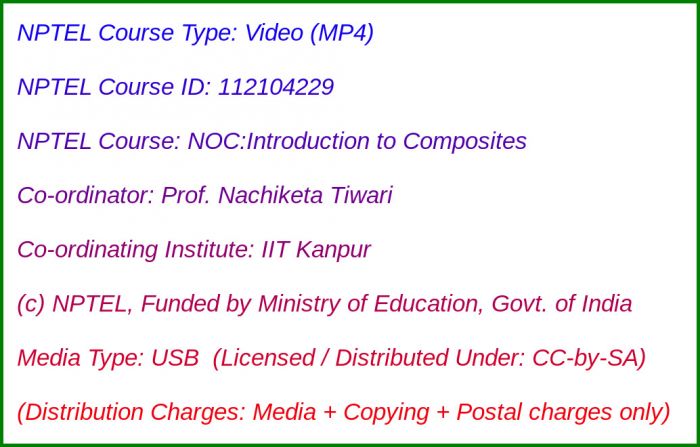
Media Storage Type : 32 GB USB Stick
NPTEL Subject Matter Expert : Prof. Nachiketa Tiwari
NPTEL Co-ordinating Institute : IIT Kanpur
NPTEL Lecture Count : 72
NPTEL Course Size : 14 GB
NPTEL PDF Text Transcription : Available and Included
NPTEL Subtitle Transcription : Available and Included (SRT)
Lecture Titles:
Lecture 1 - Definition of the composite materials
Lecture 2 - Composite materials and its applications
Lecture 3 - Classification of the composite materials
Lecture 4 - What Makes fiber so strong?
Lecture 5 - Advantages and limitations of composite materials
Lecture 6 - Properties of the composite materials.
Lecture 7 - Different Types of Fiber
Lecture 8 - Production process and different types of Glass Fiber
Lecture 9 - Graphite Fibers
Lecture 10 - Aramid and Boron Fibers
Lecture 11 - Ceramic Fibers
Lecture 12 - Matrix - Properties and classifications
Lecture 13 - Polymers as matrix material and its classification
Lecture 14 - Thermosets and thermoplastics
Lecture 15 - Properties of thermosets and thermoplastics
Lecture 16 - Thermoset materials and its production methods
Lecture 17 - Thermoplastics and metals as matrix materials
Lecture 18 - Ceramic and carbon matrices
Lecture 19 - What is a good fabrication process of a composite?
Lecture 20 - Fabrication of Thermoset Composites
Lecture 21 - Hand Lay-Up Process
Lecture 22 - Bag Molding Process
Lecture 23 - Resin Transfer Molding Process
Lecture 24 - Fabrication of Thermoplastic, Metal and Ceramic Matrix based Composites
Lecture 25 - Terminologies and basic concepts
Lecture 26 - Orthotropic material
Lecture 27 - Modeling of unidirectional composites
Lecture 28 - Composite density as a function of mass fraction and volume fraction
Lecture 29 - Calculation of longitudinal modulus for unidirectional composites
Lecture 30 - Failure modes of unidirectional composite
Lecture 31 - Failure of Unidirectional Lamina
Lecture 32 - Minimum Volume Fraction and Critical Volume Fraction
Lecture 33 - Example based on Failure of Composite Material
Lecture 34 - Example based on Minimum and Critical Volume Fraction
Lecture 35 - Transverse Modulus of Unidirectional Composite
Lecture 36 - Halpin-Tsai Relation for Transverse Modulus
Lecture 37 - Transverse modulus of unidirectional composites
Lecture 38 - Transverse strength of unidirectional composites
Lecture 39 - Poisson’s ratio of unidirectional composites
Lecture 40 - Failure modes of composite materials
Lecture 41 - Failure modes of composite materials
Lecture 42 - Other properties
Lecture 43 - Concept of Tensor
Lecture 44 - Stress Transformation (Two Dimensional)
Lecture 45 - Analysis of Specially Orthotropic Lamina
Lecture 46 - Analysis of Generally Orthotropic Lamina
Lecture 47 - Transformation of Engineering Constants - Part I
Lecture 48 - Transformation of Engineering Constants - Part II
Lecture 49 - Variation of elastic constants with respect to fiber orientation for generally orthotropic lamina
Lecture 50 - Generally orthotropic lamina
Lecture 51 - Generalized Hooke’s law for anisotropic materials
Lecture 52 - Generalized Hooke’s law for anisotropic materials
Lecture 53 - Elastic constants for Specially orthotropic materials
Lecture 54 - Elastic constants for Specially orthotropic materials in plane stress
Lecture 55 - Relation Betweeen Engineering Constants and Elements of Stiffness and Compliance Matrices - Part I
Lecture 56 - Relation Betweeen Engineering Constants and Elements of Stiffness and Compliance Matrices - Part II
Lecture 57 - Stress Strain Relations for A Lamina With Arbitrary Orientation - Part I
Lecture 58 - Stress- Strain Relation for A Lamina With Arbitrary Orientation - Part II
Lecture 59 - Strength of An Orthotropic Lamina
Lecture 60 - Importance of Sign of Shear Stress in context of Strength of A Unidirectional Lamina
Lecture 61 - Strain displacement relations for a laminate
Lecture 62 - Stress-strain relations for individual layers of a laminate
Lecture 63 - Resultant forces and moments
Lecture 64 - Relations between force and moment resultants and mid-plane strains and curvatures
Lecture 65 - Physical significance of extensional stiffness matrix [A], coupling matrix [B] and bending stiffness matrix [D] matrices
Lecture 66 - Lamination sequence (standard laminate code)
Lecture 67 - Calculation of A, B and D Matrices.
Lecture 68 - Simplification of Stiffness Matrices - Part I
Lecture 69 - Simplification of Stiffness Matrices - Part II
Lecture 70 - Quasi-Isotropic Laminates - Part I
Lecture 71 - Quasi-Isotropic Laminates - Part II
Lecture 72 - Failure of Composite Laminates

